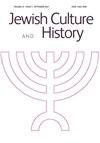Representing Hispano-Jewish and Sephardic material culture in Spain
Q4 Arts and Humanities
引用次数: 0
Abstract
On occasion of the celebration of Spain’s national day, 12 October 2017, I decided to visit the exhibition The Power of the Past: 150 Years of Archaeology in Spain, at the National Archaeological Museum (MAN) in Madrid. The display of 150 pieces assembled from different regional museums, was aimed at representing the variegated material heritage emerging from archaeological excavations across Spain since the Museum was founded in 1867. One basic underlying concept in the exhibition was the centrality of the land – the peninsula and the islands – as a crossroads of divergent cultures once established therein, and the objects were chosen to represent them. At a somber and isolated corner towards the end of the exhibition, and following the item selected to represent the Canary Islands, I noticed a display glass case containing two different sets of objects aimed at representing a new research field: Jewish medieval archaeology. It seemed to me that the exhibition’s curator felt the need to include some Jewish items, but doing it as a result of a last-minute urge he/she did not accompany it with a suitable explanation. Paradoxically, and perhaps unintentionally, the location of the glass cases contributed to enhance a sensation of seclusion within the exhibition that did not at all fit with the historical narrative of Spain’s medieval Jews, dominated by some preconceived notions, buzzwords such as Convivencia – a term originated in the early twentieth century. As a historian by training for whom textual evidence provides, among other elements, the framework for an object’s interpretation, I tried to inquire about the lack of an adequate contextualization of the chosen items to represent Jewish material culture: the first was a set of four silver platters from Briviesca, a town northeast of Burgos, found during excavation work at the old Jewish quarter destroyed in 1366. This background, and the fact that a hexagram was engraved on the platters surface, had been considered enough to display them previously in temporary exhibitions as part of a Passover service (!!). A tiny inscription in Latin script engraved on the back, though, would suggest that the set had originally been made for, and owned by, Christians. We could assume, only hypothetically, that the platters found their way into Jewish hands after being pawned. It is pertinent to raise the question here of what makes an (or not so-) ordinary object Jewish? With the exception of a limited typology of Jewish ceremonial objects, a Jewish home was not substantially different from a non-Jewish代表西班牙的西班牙裔犹太人和塞法迪人物质文化
在2017年10月12日庆祝西班牙国庆之际,我决定参观马德里国家考古博物馆举办的展览《过去的力量:西班牙考古150年》。展出了来自不同地区博物馆的150件藏品,旨在展示自1867年博物馆成立以来,西班牙各地考古发掘中涌现出的丰富多彩的物质遗产。展览中的一个基本概念是,半岛和岛屿是这片土地的中心,一旦在其中建立起来,就会成为不同文化的十字路口,并选择代表它们的物品。在展览即将结束的一个昏暗而孤立的角落,在被选为加那利群岛代表的物品之后,我注意到一个展示玻璃箱,里面有两套不同的物品,旨在代表一个新的研究领域:犹太中世纪考古。在我看来,展览的策展人觉得有必要包括一些犹太物品,但由于最后一刻的催促,他/她没有给出合适的解释。矛盾的是,也许是无意的,玻璃柜的位置有助于增强展览中的一种与世隔绝的感觉,这种感觉与西班牙中世纪犹太人的历史叙事完全不符,这些犹太人被一些先入为主的观念所主导,流行语如Convivencia——一个起源于20世纪初的术语。作为一名受过训练的历史学家,文本证据为其提供了解释物体的框架等要素,我试图探究所选物品是否缺乏足够的语境来代表犹太物质文化:第一个是来自布尔戈斯东北部城镇布里维斯卡的一套四个银盘,在1366年被摧毁的旧犹太区的挖掘工作中发现。这种背景,以及在盘子表面刻上一个卦的事实,被认为足以在之前作为逾越节服务的一部分在临时展览中展示它们(!!)。不过,背面刻着一个拉丁文的小铭文,这表明这套餐具最初是为基督徒制作的,并归基督徒所有。我们可以假设,只是假设,这些盘子是在被典当后落入犹太人手中的。在这里提出一个问题是恰当的,是什么让一个(或不是)普通的物体成为犹太人?除了犹太仪式物品的有限类型外,犹太人的家与非犹太人的家没有实质性的区别
本文章由计算机程序翻译,如有差异,请以英文原文为准。
求助全文
约1分钟内获得全文
求助全文

 求助内容:
求助内容: 应助结果提醒方式:
应助结果提醒方式:


